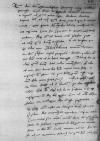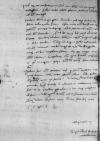Letter #2551
Sigmund von HERBERSTEIN to Ioannes DANTISCUSVienna, 1541-03-22
| received Marienburg (Malbork), 1541-05-10 Manuscript sources:
Auxiliary sources:
Prints:
| ||||||||||||
Text & apparatus & commentary Plain text Text & commentary Text & apparatus
Reverendissimo Domino, domino
Reverendissime Domine, domine observandissime. Servitiorum meorum commendatione praemissa.
Cum nuper in Septembri
Scriberem nova, si quae essent iucunda, sed utique scribam ex debito talia, qualia sunt.
Datae
Eiusdem Vestrae Reverendissimae Dominatonis obsequentissimus
[1 ] See cf.
[3 ] See cf.
[4 ] We know the names of Jost Ludwig Decius’ (see footnote 6) two sons-in-law: one was
[6 ] A reference to cf.
[7 ] Herberstein stayed in Vilnius from c. September 26 to October 5, 1540, cf. cf.
[8 ] Decius left Cracow for Silesia on October 16, two days before Herberstein’s arrival in Cracow from Vilnius (see cf. Sigmund Herberstein, Sigmunds von Herberstein Selbstbiographie, ed. by Th. G. von Karajan, Wien, 1855, series: Fontes Rerum Austriacarum I Abteilung, Scriptores Band 1 ⌊HERBERSTEIN 1855cf. Sigmund Herberstein, Sigmunds von Herberstein Selbstbiographie, ed. by Th. G. von Karajan, Wien, 1855, series: Fontes Rerum Austriacarum I Abteilung, Scriptores Band 1 ⌋, p. 327; cf. Elementa ad fontium editiones 48. Res Polonicae ex Archivo Regiomontano, XVIII pars (AD. 1539-1541), vol. 48, ed. by Karolina Lanckorońska, Roma, 1979 ⌊EFE 48cf. Elementa ad fontium editiones 48. Res Polonicae ex Archivo Regiomontano, XVIII pars (AD. 1539-1541), vol. 48, ed. by Karolina Lanckorońska, Roma, 1979 ⌋, No. 378-379, p. 132, 134, cf. office copy, BCz, 245, p. 237, in the center of the page; footnote 13; cf.
[9 ] Unknown letter
[10 ] Unknown letters
[11 ] The mentioned letter of Herberstein to Cornelis De Schepper (see cf.
[12 ] Dantiscus wrote to Herberstein immediately upon receiving the letters from Herberstein and De Schepper on October 5, 1540, and then c. January 10, 1541. Neither of these letters reached Herberstein and they are only known from mentions (see footnote 13; cf.
[13 ] Charles V was in Regensburg from February 24 to April 23 and from May 3 to July 28, 1541, at the Reich diet which he opened on April 5.The diet was dominated by the religious dispute, started in Hagenau (cf. cf.
[14 ] A reference to the political and military operation undertaken in autumn 1540 by Ferdinand I upon receiving news of the death of János I Zápolya (see letter No. 31, footnote 2), aimed at securing the rights to the Kingdom of Hungary and taking control of it. Suleiman I’s response was military intervention and occupation of Buda (1541), which resulted in the division of the Kingdom of Hungary (see cf. Andrzej Dziubiński, Stosunki dyplomatyczne polsko-tureckie w latach 1500-1572 w kontekście międzynarodowym, Wrocław, Fundacja na rzecz Nauki Polskiej, 2005 ⌊DZIUBIŃSKIcf. Andrzej Dziubiński, Stosunki dyplomatyczne polsko-tureckie w latach 1500-1572 w kontekście międzynarodowym, Wrocław, Fundacja na rzecz Nauki Polskiej, 2005 ⌋, p. 133-147; cf. Paula Sutter Fichtner, Ferdinand I of Austria: The Politics of Dynasticism in the Age of Reformation, New York, 1982 ⌊Fichtnercf. Paula Sutter Fichtner, Ferdinand I of Austria: The Politics of Dynasticism in the Age of Reformation, New York, 1982 ⌋, p. 122-139; cf. Alfred Kohler, Ferdinand I. 1503-1564. Fürst, König unf Kaiser, München, 2003 ⌊KOHLER 2003cf. Alfred Kohler, Ferdinand I. 1503-1564. Fürst, König unf Kaiser, München, 2003 ⌋, p. 213-215, cf. cf. Sigmund Herberstein, Sigmunds von Herberstein Selbstbiographie, ed. by Th. G. von Karajan, Wien, 1855, series: Fontes Rerum Austriacarum I Abteilung, Scriptores Band 1 ⌊HERBERSTEIN 1855cf. Sigmund Herberstein, Sigmunds von Herberstein Selbstbiographie, ed. by Th. G. von Karajan, Wien, 1855, series: Fontes Rerum Austriacarum I Abteilung, Scriptores Band 1 ⌋, p. 329-337; cf. Gratae posteritati Sigismundus liber baro in Herberstein Neyperg et Guettenhag, primarius ducatus Carinthiae hereditariusque et camerarius … actiones suas a puero ad annum usque aetatis suae septuagesimum quartum brevi commentariolo notatas reliquit, Vienna, Raphael Hofhalter, 1560 ⌊HERBERSTEIN 1560cf. Gratae posteritati Sigismundus liber baro in Herberstein Neyperg et Guettenhag, primarius ducatus Carinthiae hereditariusque et camerarius … actiones suas a puero ad annum usque aetatis suae septuagesimum quartum brevi commentariolo notatas reliquit, Vienna, Raphael Hofhalter, 1560 ⌋, f. D4r-v; cf. Elementa ad fontium editiones 43. Documenta ex Archivo Regiomontano ad Poloniam spectantia XIII pars H B A, B 2a, 1534-65, ed. by Karolina Lanckorońska, Roma, 1978 ⌊EFE 43cf. Elementa ad fontium editiones 43. Documenta ex Archivo Regiomontano ad Poloniam spectantia XIII pars H B A, B 2a, 1534-65, ed. by Karolina Lanckorońska, Roma, 1978 ⌋, No. 11, p. 8, cf. Elementa ad fontium editiones 45. Documenta ex Archivo Regiomontano ad Poloniam spectantia XIV pars H B A, B 3, 1525-72, ed. by Karolina Lanckorońska, Roma, 1977 ⌊EFE 45cf. Elementa ad fontium editiones 45. Documenta ex Archivo Regiomontano ad Poloniam spectantia XIV pars H B A, B 3, 1525-72, ed. by Karolina Lanckorońska, Roma, 1977 ⌋, No. 32, p. 30-31; cf. Elementa ad fontium editiones 48. Res Polonicae ex Archivo Regiomontano, XVIII pars (AD. 1539-1541), vol. 48, ed. by Karolina Lanckorońska, Roma, 1979 ⌊EFE 48cf. Elementa ad fontium editiones 48. Res Polonicae ex Archivo Regiomontano, XVIII pars (AD. 1539-1541), vol. 48, ed. by Karolina Lanckorońska, Roma, 1979 ⌋, No. 373-374, p. 122-128, No. 376-379, p. 129-135, No. 380, p. 136-139, No. 383, p. 140-143, No. 387, p. 145-152, No. 389, p. 154-155, No. 392-393, p.161-172; cf cf.
[15 ] In October and November 1540, Ferdinand’s troops under the command of Leonard von Fels advanced on Buda, took Pest, and because of the coming of winter, withdrew, seizing en route the castles of Tata and Visegrád (see cf. Andrzej Dziubiński, Stosunki dyplomatyczne polsko-tureckie w latach 1500-1572 w kontekście międzynarodowym, Wrocław, Fundacja na rzecz Nauki Polskiej, 2005 ⌊DZIUBIŃSKIcf. Andrzej Dziubiński, Stosunki dyplomatyczne polsko-tureckie w latach 1500-1572 w kontekście międzynarodowym, Wrocław, Fundacja na rzecz Nauki Polskiej, 2005 ⌋, p. 138, cf. cf. Elementa ad fontium editiones 36. Res Polonicae ex Archivo Regiomontano, VI pars (AD. 1538-1542), vol. 36, ed. by Karolina Lanckorońska, Roma, 1975 ⌊EFE 36cf. Elementa ad fontium editiones 36. Res Polonicae ex Archivo Regiomontano, VI pars (AD. 1538-1542), vol. 36, ed. by Karolina Lanckorońska, Roma, 1975 ⌋, No. 663, p. 100, No. 675, p. 113, No. 680, Annexum VI, p. 130, No. 681, p. 133-134, cf. Elementa ad fontium editiones 48. Res Polonicae ex Archivo Regiomontano, XVIII pars (AD. 1539-1541), vol. 48, ed. by Karolina Lanckorońska, Roma, 1979 ⌊EFE 48cf. Elementa ad fontium editiones 48. Res Polonicae ex Archivo Regiomontano, XVIII pars (AD. 1539-1541), vol. 48, ed. by Karolina Lanckorońska, Roma, 1979 ⌋, No. 406, p. 187-192, cf. No. 416, Annexum I, p. 213-215; cf. Johannes Voigt, "Briefwechsel des Freih. Sigismund von Herberstein mit dem Herzog Albrecht von Preußen", in: Archiv zur Kunde österreichische Geschichtes-Quellen vol. 17/2, Wien, p. 265-293 ⌊VOIGT 1857cf. Johannes Voigt, "Briefwechsel des Freih. Sigismund von Herberstein mit dem Herzog Albrecht von Preußen", in: Archiv zur Kunde österreichische Geschichtes-Quellen vol. 17/2, Wien, p. 265-293 ⌋, p. 281)
[16 ] Probably a reference to the Turkish camp near Pest; Ferdinand I decided to fortify Pest in order to take Buda (cf. Paula Sutter Fichtner, Ferdinand I of Austria: The Politics of Dynasticism in the Age of Reformation, New York, 1982 ⌊Fichtnercf. Paula Sutter Fichtner, Ferdinand I of Austria: The Politics of Dynasticism in the Age of Reformation, New York, 1982 ⌋, p. 125). On Ferdinand I’s leaving for Regensburg see cf.
[17 ] Herberstein means Dantiscus could take part in the negotations on the Hungarian issue, yet Dantiscus himself found this suggestion a friendly courtesy (see cf. Elementa ad fontium editiones 45. Documenta ex Archivo Regiomontano ad Poloniam spectantia XIV pars H B A, B 3, 1525-72, ed. by Karolina Lanckorońska, Roma, 1977 ⌊EFE 45cf. Elementa ad fontium editiones 45. Documenta ex Archivo Regiomontano ad Poloniam spectantia XIV pars H B A, B 3, 1525-72, ed. by Karolina Lanckorońska, Roma, 1977 ⌋, ll. 50-57)
[18 ] After the Ascanio Colonna’s dispute with pope Paul III concerning his raising of salt prices in 1539 (which was contrary to the privilege granted to the Colonnas by pope Martin V) was initially appeased, and after an agreement was concluded by Charles V with the Colonnas’ support, in February 1541 some of the Colonnas’ clients were arrested after refusing to pay higher prices for salt. Despite the intervention of the imperial ambassador in Rome, Vittorio Colonna, and the viceroy of Naples, Pedro de Toledo, Ascanio Colonna decided on military action, which ended in his defeat, confiscation of the Colonna estates in Rome and Campagna (returned only after the death of Paul III) and Ascanio having to emigrate to his estate in the Kingdom of Naples. Ioannes Decius sent Duke Albrecht von Hohenzollern news of Ascanio Colonna’s plundering in cities dependent on the pope, which some said had been done with the emperor’s consent, from Padua on May 20, 1541 (cf. Elementa ad fontium editiones 45. Documenta ex Archivo Regiomontano ad Poloniam spectantia XIV pars H B A, B 3, 1525-72, ed. by Karolina Lanckorońska, Roma, 1977 ⌊EFE 45cf. Elementa ad fontium editiones 45. Documenta ex Archivo Regiomontano ad Poloniam spectantia XIV pars H B A, B 3, 1525-72, ed. by Karolina Lanckorońska, Roma, 1977 ⌋, No. 37, p. 34)
[19 ] Probably a reference to Francis I’s position concerning the Hungarian issue after the death of János I Zápolya (July 21, 1540). Having recognized the right of Zápolya’s son, the infant János II Sigismund Zápolya (b. July 7, 1540) to the Hungarian throne, Suleiman I encouraged Francis I to make things difficult for Charles V in the west, so that he would be unable to help his brother Ferdinand I in operations aimed at taking over Hungary. Taking into account that the infant heir to the throne might die, some of the Hungarian states intended to proclaim Charles, Duc d'Orleans, as the king with the sultan's consent (see letter No. 40, footnote !!!). Perhaps Herberstein’s remark is also an allusion to the marriage – arranged by Francis I and concluded on June 14, 1540 – between the heiress to the Kingdom of Navarre, Jeanne d’Albret, and Wilhelm V, duke of Jülich-Kleve-Berg, brother-in-law of Johann Friedrich, Saxon elector. At the time, duke Wilhelm was involved in a dispute with the emperor over the rights to Guelders (see letter No. 37, footnote !!!), while Jeanne’s father and Francis I’s brother-in-law, king of Navarre Henri d’Albret was holding secret negotiations with the emperor. The marriage was annulled by the pope in 1545 (see cf. Ion Ursu, La politique orientale de François I-er, Paris, 1908 ⌊URSUcf. Ion Ursu, La politique orientale de François I-er, Paris, 1908 ⌋, p. 123-126; cf. Robert Jean Knecht, Renaissance Warrior and Patron: The Reign of Francis I, Cambridge, 1994 ⌊Knechtcf. Robert Jean Knecht, Renaissance Warrior and Patron: The Reign of Francis I, Cambridge, 1994 ⌋, p. 396, 478-479, 487). In his letter from Padua dated May 20, 1541, Ioanes Decius informed Duke Albrecht von Hohenzollern that Francis I had sent several thousand infantry towards Turin (cf. Elementa ad fontium editiones 45. Documenta ex Archivo Regiomontano ad Poloniam spectantia XIV pars H B A, B 3, 1525-72, ed. by Karolina Lanckorońska, Roma, 1977 ⌊EFE 45cf. Elementa ad fontium editiones 45. Documenta ex Archivo Regiomontano ad Poloniam spectantia XIV pars H B A, B 3, 1525-72, ed. by Karolina Lanckorońska, Roma, 1977 ⌋, No. 37, p. 34)
[20 ] Probably a reference to special monitoring and safeguarding of ports within the Kingdom of Naples in connection with the threat from Barbarossa’s fleet (see cf.


